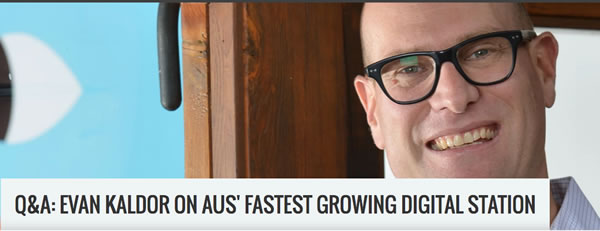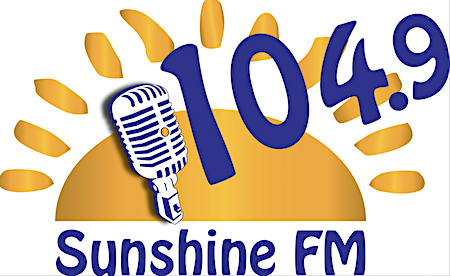Q and A – Evan Kaldor on Kinderling

Just one year into its inception, Kinderling Kids Radio cracked the Top 10 digital radio stations in Australia, has capitalised on the format’s tipping point through network and media partnerships, and is now the fastest growing digital radio station in the country.
Using research findings to define its market, Kinderling rails against conventional kids radio programming, playing everything from Bob Marley and Taylor Swift, to AC/DC and Daft Punk. Its team includes music industry stalwarts Lorna Clarkson (founder of CD-R in Sydney) and Tim Ritchie (ex-Double J, triple j and Radio National) and its presenters include music journalist Barry Divola, HG Nelson (This Sporting Life) and Chris Taylor (The Chaser).
TMN chats to Kinderling’s Managing Director (and former FBi Radio General Manager) Evan Kaldor, about why a format that failed in the UK is working so well here, the research findings that defined the station, and his plans for its future.
A year on from Kinderling’s inception, what have you learned about Australia’s consumption of kids’ radio?
We’ve been hugely encouraged by the response from audiences across the country. We are now the fastest growing digital radio station in Australia and that tells us there is a substantial audience for family focused radio. DAB+ penetration feels much more widespread within our audience – people told us at the start that digital radio was still an emerging platform but we feel it’s at a tipping point within our demographic, either having a digital radio in their homes (most likely kitchens) or in their cars. That said, we launched our free App in February for iOS and Android that enables easy live and catch-up streaming of all our programs and that has also been propelling our audience growth and engagement.
Kinderling cracked the Top 10 digital radio stations in Australia just 10 months in. What do you put its success down to?
Kinderling has a fantastic programming team with deep experience in radio and the music industry. I put our success down to their ability to develop a programming model that balances content for children as well as parents in that listening environment. In particular, I think parents are impressed by what we play and it is a station that is easy for them to listen to.
We’ve also been very fortunate to work with a number of partners such as SCA, the BBC and Child magazines that have helped spread the word.
As the former GM of FBi, you couldn’t have chosen a more different target demographic with Kinderling. Tell us about the research findings that helped form the station’s ethos?
From a music perspective, Kinderling is FBi’s godchild – our audience is very much FBi/RRR/PBS listeners with kids. Almost all the Kinderling team come from a community or public radio background and that infuses how we think about programming, sponsorship and the relationship with our audience.
It terms of the research that underpins our programming, we spent two years before launch developing an understanding of the routine of an Australian household with kids. We looked at the published evidence, conducted our own market research with parents and consulted with midwives and mothercraft nurses. We were able to develop a highly accurate picture of a daily (and nightly) routine. Our programming was then designed to modulate according to what is happening in that part of the routine – high energy during periods of peak activity and calm and soothing when things are cranky.
When we did our research with families about what they played for their kids in cars and homes, we found the universe of music is much broader than you might think – from Bob Marley to the Black Keys. This aligned with our own view that kids respond to all forms of music so we wanted our station to reflect what our audience are actually playing – as opposed to the conventional idea that it has to all be ‘kids music’. Clearly we read the lyrics of everything played to ensure the songs are G-rated but within a day a child might hear music from Daft Punk to vintage blue grass to De La Soul and Ezra Furman, as well as Sam Moran, Lah-Lah and Taylor Swift.
Kinderling is at the forefront of children’s radio in Australia, yet the BBC in the UK famously axed many of its kids’ shows in 2009 and again in 2011. Why is kids’ radio working so well locally?
Five years ago iPads were just emerging and linear broadcasting was under threat. I think since that time, parents have become conscious of their use of small screens and they are open to how they can supplement or complement that activity with more passive engagement – listening as opposed to watching. Radio is seen as a safe media and we benefit from that perception. I have only positive things to say about the BBC – they are one of our Australian partners and have been one of the most progressive and supportive. They saw the potential of what we were doing and jumped in early.
I think Australian audiences appreciate a local voice promoting local content, and we are certainly focused on that.
The music industry has backed Kinderling in a big way; you have partnerships with SCA, the BBC, Child Magazines and in a smaller capacity VIVID. Was the young audience market ignored before?
We’ve seen from our time at FBi the important role a station can play in introducing audiences to new music. We are broadcasting nationally and are using that platform to support new releases, new artists and promote tours in local areas. For labels and managers that have kids titles in their roster, there are very few dedicated marketing channels, and we have already established ourselves with this landscape.
The Kinderling team aren’t new to the music industry. Lorna Clarkson, our Music Director, founded CD-R here in Sydney and is part of the Red Bull Music Academy so she knows a lot about supporting artists. Tim Ritchie, our Head of Content, was at Double J, JJJ and Radio National for over 40 years (and one of the first music DJs in Australia). One of feature shows, Regression Sessions, is presented by music journalist Barry Divola. We have lots of ideas and opportunities so always open to doing more with the labels and industry.
We did a great initiative last year with Universal / Deutsche Gramaphone for the Max Richter CD “For Sleep”. We programed a week of content about how to help kids sleep and each night broadcast the full 8 hour lullaby uninterrupted.
What‘s the average age of your listeners and what do you think that means?
Kinderling speaks to everyone in the family. During prime breakfast and drive time, Kinderling plays music pitched at 4 – 6 year olds. In the middle part of the day we play active music for toddlers, and at lunch time we broadcast a live parenting show aimed at making life easier for carers. In the evening, we help babies go to sleep by playing ambient music / white noise. On Saturday mornings,We Was Robbed with HG Nelson and Chris Taylor talks to the sports keen members of the family.
With 16 radio programs, conversation segments for parents and a healthy social media presence that at times posts viral-worthy articles and videos, Kinderling has many bases covered. But what changes or additions can we expect in the next 12 months?
I think you’ll be seeing us on more platforms and in more places. We have a really interesting program in development that’s focused in the education and learning space. Our breadth of contributors are expanding and we will be doing more with leading experts as well as commissioning original local content.
Read more in The Music Network here.


